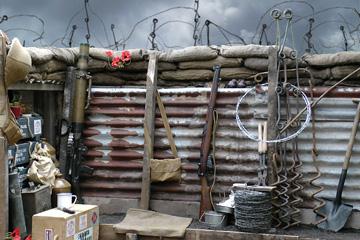Life on the Front Line

First World War family history day at Museum of Liverpool
The Museum of Liverpool will host a free First World War family history event on Saturday 28 September, to help people search for relatives who served in the war. The day will also feature a replica First World War trench in the Museum’s Atrium, so that visitors can get a sense of what life was really like for those who fought on the front line.
The Museum, which looks after the collections of The King’s Regiment displayed in the City Soldiers gallery, is working with local experts and societies to assist in research of soldiers from the area.
Experts and historians from a number of local societies will be on hand to assist with family history research between 10am and 4pm, and visitors can gain access to a research database, which contains the biographical details of over 76,000 men who served in the King’s Regiment during the First World War.
There will be a range of family friendly activities on offer throughout the day including ‘Meet the Experts’, talks by First World War historical experts, performances and roleplayers, and arts and crafts for younger visitors.
Visitors can also meet the Museum’s own King’s Regiment ‘Tommy Atkins’ and see what his life in a trench was like, or learn about the embroidered postcards he sent home. The Liverpool Welsh Choral will also be performing in the afternoon.
There will be experts on hand from:
• National Museums Liverpool
• Local King’s Regiment historians
• The Western Front Association
• Liverpool Family History Society
• The Liverpool First World War Research Committee
• The Liverpool Pals
• The King’s Regiment Association
• The Liverpool History Society
• John Moores University
• The University of Liverpool
The King’s Regiment Collection at the Museum of Liverpool
City Soldiers – Created in 1685, the King’s Regiment is one of Britain’s oldest regiments. It has been Liverpool’s regiment since 1881, and is now amalgamated into the Duke of Lancaster’s Regiment. Focusing on its long history and relationship with the city, the gallery utilises the King’s Regiment collection, which includes film, video, memoirs, uniforms, medals, trophies and weaponry, to tell the Regiment’s story. Visitors will be inspired to research their family history, using the collection and archive information as a starting point.
Notes to editors:
Museum of Liverpool
The Museum of Liverpool is the country’s most visited museum outside of London. It is the largest newly-built national museum in Britain for more than a century, demonstrating Liverpool’s unique contribution to the world.
The first national museum devoted to the history of a regional city, it showcases popular culture while tackling social, historical and contemporary issues. It has attracted more than two million visitors since opening in July 2011. The prestigious Council of Europe Museum Prize for 2013 was awarded to the Museum for its commitment to human rights as well as its work with children and families from all backgrounds.
The Museum has received generous support from several major funders, and grants from trusts and foundations, corporate support and individual donations. Major funders include the Northwest Regional Development Agency (NWDA), The European Regional Development Fund (ERDF), the Heritage Lottery Fund (HLF), the Department for Culture Media and Sport (DCMS),Garfield Weston Foundation and the Clore Duffield Foundation.
The Northwest Regional Development Agency (NWDA) was responsible for the sustainable economic development and regeneration of England’s Northwest and had five key priorities: Business, Skills and Education, People and Jobs, Infrastructure and Quality of Life.
The European Development Fund (ERDF) is making a real difference to people and businesses in the North West. With €755 million to invest between 2007 and 2013, ERDF is enhancing the competitiveness of the region’s economy by supporting growth in enterprise and employment. ERDF in the North West is managed by the Department for Communities and Local Government – for further information visit www.communities.gov.uk/erdf.
Using money raised through the National Lottery, the Heritage Lottery Fund (HLF) sustains and transforms a wide range of heritage for present and future generations to take part in, learn from and enjoy. From museums, parks and historic places to archaeology, natural environment and cultural traditions, we invest in every part of our diverse heritage. HLF has supported more than 30,000 projects allocating £4.5billion across the UK. www.hlf.org.uk
About National Museums Liverpool
National Museums Liverpool comprises eight venues, including some of the most visited museums in England outside of London. Our collections are among the most important and varied in Europe and contain everything from Impressionist paintings and rare beetles to a lifejacket from the Titanic. We attract more than 3 million visitors every year. Our venues are the Museum of Liverpool, World Museum, the Walker Art Gallery, Merseyside Maritime Museum, International Slavery Museum, Border Force National Museum, Sudley House and the Lady Lever Art Gallery.
